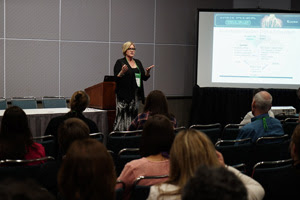 by Sherry Waldon Wells, Ed.D, Vice Provost for Digital Learning, Lamar University
by Sherry Waldon Wells, Ed.D, Vice Provost for Digital Learning, Lamar University
In the session “Student Digital Experience: Making Sense of the Mess” on the first full day of AACRAO 2019, Aaron Apel & Beth Warner from the University of Wisconsin-Madison described the “new and shiny” phenomenon which resulted in the students at their institution having to navigate multiple applications which were not integrated. In the effort to remain current with technology, a variety of computer applications, systems, and online resources had proliferated on campus, as often happens. For example, a student may navigate through the applications and get to the very end only to discover a road block such as a requisite for the course.
The UW-Madison team posed the question: just because you can do something, does that mean you should do it? To answer that question Apel & Warner presented two case studies in their session.
Student enrollment
The first case study was on student enrollment. The legacy process required system modifications and time consuming training of advisors and students on how to use the systems. It also required a robust help desk support structure. To address the issue campus stakeholders were engaged to identify the pain points. Campus stakeholders included student orientation (SOAR), the Student Advisory Board, and the Academic Advising Board.
The solution: Creating one application that performed all of the functions such as validating course requisites at the time of adding the course to the cart instead of at the end of the process. Other functionality such as degree planner would be included in this “one stop shop” for enrollment. Measures of success included a 30% increase in ease of use being reported from users, less training required of advisors and students, deprecation of two systems and 32 software customizations.
Academic and curricular policy repository
The second case study was on academic and curricular policy repository. The legacy process was paper-based and manual with no integration and poor communication. Decisions made on courses and programs were made on the academic side with the assumption the change would be implemented even though many times the changes were not communicated to the office actually maintaining the information in the system.
The solution: A task force was created to examine the issue resulting in the recommendation that a service unit be created to provide coordination and support, to promote oversight and administration of a single source repository. As a result the Academic & Curricular Policy Repository Advisory Committee formed. Through this committee process requirements and program information were standardized across departments making it easier for advisors and students to find the information needed to schedule classes. With the new process came an understanding that if changes to courses or programs were not sent to the repository then they were not officially implemented. To soften the blow departments were permitted to review course requisites globally and make changes instead of having to submit changes on each course.
Apel and Warner were frank that the process has been ongoing for several years and continues to evolve. A question from the audience brought accessibility into the conversation. The response was that every step the university accessibility office was consulted and tested the new processes to insure that nothing was implemented that would not be accessible.